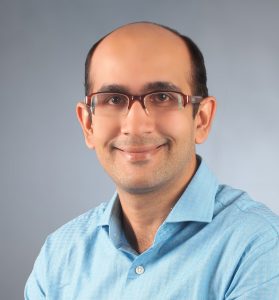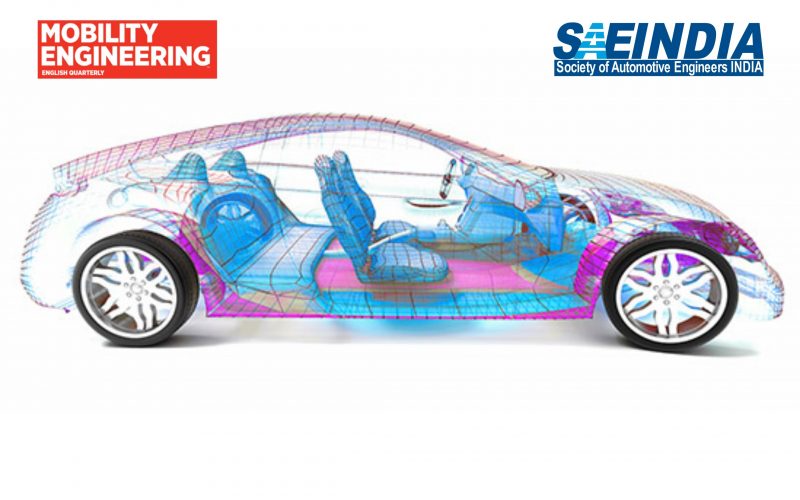Mobility Engineer 2030 – building Future Skills for automotive Engineers
How can Universities bridge the gap in engineering education and create industry-ready students?
Introduction
The Automotive Industry is being disrupted by technologies such as electric, autonomous and connected vehicles. The industry is also disrupted by radically new business models like shared mobility. The technologies that enable these disruptions – AI, IoT, Robotics, Renewable Energy, Energy storage, Advanced materials, Additive manufacturing etc – are all growing exponentially and are fast converging to create refreshingly new products and services. The focus of innovators is shifting from product level innovation to ecosystem level innovation that leads to mobility as a service. The mobility industry needs innovators who are trained in multiple branches of engineering – mechanical, electrical & electronics, computer engineering – to develop these next-gen technologies [1]. Since the technologies are growing exponentially, there is little time available for us to acquire cross-domain training and practise our skills on solving cross-domain engineering problems. We (students, faculties, automotive professionals) all need to reskill ourselves in the next three years for us to effectively contribute to the development of next-gen mobility products during 2025 – 2030. The rapid growth of mobility sector is expected to create millions of new jobs, but we may not have the necessary skills unless we bring some radical changes to the way we learn and teach mobility technologies at our Universities.
Key Challenges for Universities
- How to align the courses to the needs of the industry
If our objective is to create industry-ready students, then the courses should be designed to go beyond concepts and focus a lot on real-world problem solving. The courses need to be sequenced such that there is a logical flow from conceptual foundations to real world practice. The course content is based on standard books and the exams are designed to assess the conceptual understanding. How to take this engineering education to the next level of building real-world application on top of the conceptual foundation?
- How to bring the various engineering departments together to co-create courses
The courses to be taught will be inter-disciplinary in nature and will require faculty members from various departments to come together to design and offer courses. However, most of the courses taught today are offered within the department. Even a course like automotive engineering is offered by the mechanical engineering department in most universities and institutions. Since the next-gen mobility technologies span across multiple engineering domains like mechanical, electrical & electronics, computer science etc, we need inter-disciplinary centres to design and train the next generation of engineers.
- How to expose students and teachers to product development and industry practices
Industry readiness is all about stitching together the knowledge that we gained from various courses across the four years undergrad curriculum to design a robust product. The product seamlessly cuts across multiple engineering domains and the engineering problems to be solved are at the interface of traditional engineering domains. For instance, designing a battery for EV involves mechanical considerations from vehicle integration perspective, thermal considerations from the perspective of thermal management to achieve optimum performance, electrical considerations to balance the cells in the pack, electronics – sensors and controls for battery management etc. The industry practice goes beyond demonstrating technical feasibility – it involves demonstrating scalability, manufacturability, commercial viability etc. We need to train the faculty and students to analyse technologies holistically from real-world application perspective.
Pathways to Transformation – 3Cs
- Collaboration – The various engineering departments within the University should collaborate to design offer courses that are product oriented. A course on EV would require faculty members from mechanical, electrical & electronics and computer science collaborating and co-creating. The Universities need to collaborate with the Industry to build product design and performance insights into the course. Such courses are best taught jointly by academic and industry experts.
- Concept to Practice – The teaching has to go beyond the concepts and extend to practice. Adopting global best-practices and frameworks like CDIO – where every topic is taught through Concepts, Design practices, Implementation methods and Operationalization models – will go a long way in equipping students to prepare for their career in the automotive industry. CDIO was originally invented by two professors from MIT to prepare aerospace engineering students to meet the demanding requirements of the aerospace industry. CDIO has evolved over the years and has found wide acceptance in industry and academia alike. CDIO is an innovative educational framework for producing the next generation of engineers.The framework provides students with an education that focuses on engineering fundamentals set in the context of Conceiving — Designing — Implementing — Operating (CDIO) real-world systems and products [2].
- Cross- Sabbaticals – “You can’t understand someone until you’ve walked a mile in their shoes.” – it would do good for industry professional to spend some time in a University and academic experts to spend some time in the industry. The exposure should be long enough for the person to immerse in the new environment and work as a member of the team. While students do get summer internship opportunities in the industry, they are typically for 1-2 months. One of the IITs (Jodhpur) designed their student summer internship such that their students go as small teams to the same company every summer for all the four years – this allowed the students to get significant exposure and demonstrate tangible outcomes from their projects. Young faculty members rarely get the opportunity to go to industry. Industry professionals rarely go to University and spend a few months either to teach or research. Can we create mini-sabbaticals (3 – 6 months) where faculty members work in the Industry and industry professionals teach / research in the University?
Examples of well implemented ideas
- How to create product – oriented trainings (EV as an example)
Universities need to integrate modular certificate courses into the curriculum. These courses can be either industry or application specific. Industry experts and professional trainers can be leveraged to design and teach these courses. The biggest challenge is that an engineer does not even know what applications exist for the knowledge they are gaining. The institutes have to move beyond inviting industry experts to give guest lectures and bring actual field problems to the fore-front. Figure 1 depicts how automotive OEMs can train the fresh graduate and post-graduate engineers during their technical induction period. The training is aimed at bridging the gap between what these students have learnt at the University versus the practical skills that they need to have to start working on technology projects in the industry. The technical training is structured in three layers – engineering foundation, specialization and super-specialization. The engineering foundation covers engineering and project management practices along with an introduction to Data Science. The specialization courses are specific to the group in which the engineer will be working. The super-specialization topics cover emerging technologies like electric, connected and autonomous vehicles.
Graduates either want to work in a big company or pursue higher education or pursue their start up idea. University curriculum presently puts all of them in a single category, thereby not equipping them for alternative career choices. Many energetic engineers jump into launching a startup venture or head into incubation without a proper road map or without a basic level of validation for the idea. The academia can help by grooming them as a quasi-entrepreneur by adding additional business-oriented problem statements or constraints to their projects. They can train students to use the business canvas in a structured way so that they have a clear understanding of the customer needs, stakeholder expectations, the challenges in taking their idea to the market etc.
The classroom of the engineering college has to be totally restructured. The lecture should be disseminated in a lab environment with actual physical touch and feel of the components and the physics needs to be explained in real terms. The lab environment should have simulators, demo rigs as well as kits for providing full visualization at least for miniature models. An engineer embarking to work as a systems engineer for an Electric Vehicle program needs to know vehicle dynamics, battery chemistry, kinematics, electric motors, electronic controls, data communication etc. Today we are failing to equip the graduates with the elements to succeed. The Figure 2 shows a view of the mobility industry and how cross-disciplined it is. The primary skills are depicted in the vertical column (white boxes) and the secondary skills are depicted in the horizontal row (black boxes). So, it is critical that the Universities provide cross-domain exposure to the students. These students, when they join the industry, will be able to comfortably work in cross-functional teams (CFTs) and build EV products that cut across the various domains depicted in the Figure. To keep the discussion simple, we have shown the ten most important domains and this simple framework itself leads to 90 intersection points. These intersection points represent the opportunities for innovation that can be tapped if the engineer has cross-domain exposure.
- How Academic Professors used their sabbaticals to transform the Industry
Academicians, when they go the industry on a sabbatical assignment, have the potential to challenge the assumptions and drive fresh thinking. There have been many instances when they created innovative new product ideas for business growth, transformed the culture of the company and made a big impact. Here are two such academicians whom one of the authors (SV) had met and derived inspiration from.
- Professor Vijay Govindarajan – Innovation
Professor Vijay Govindarajan, popularly known as VG, is the Coxe Distinguished Professor at Dartmouth College’s Tuck School of Business. Govindarajan served as General Electric‘s first Chief Innovation Consultant and Professor in Residence from 2008–10. While working at General Electric, Govindarajan co-authored a paper entitled “How GE Is Disrupting Itself” with Chris Trimble and GE’s CEO Jeffrey Immelt. “How GE Is Disrupting Itself,” which introduced the idea of “Reverse Innovation”. The process of reverse innovation begins by focusing on needs and requirements for low-cost products in countries like India. Once products are developed for these markets, they are then sold elsewhere – even in the West – at low prices which creates new markets and uses for these innovations. GE sells an ultra-portable electrocardiograph machine in the U.S. at an 80% markdown for similar products. The machine was originally built by GE Healthcare for doctors in India and China. VG has coached many industry professionals on the strategic aspects of driving reverse innovation in their industries [3].
(b) Professor George Stephanopoulos – Intrapreneurship
Greg N. Stephanopoulos is an American chemical engineer and the Willard Henry Dow Professor in the Department of Chemical Engineering at the Massachusetts Institute of Technology. In 2000 his professional life took a drastic turn when he took a temporary leave from MIT and joined Mitsubishi Chemical Corporation (MCC) as their Chief Technology Officer and Executive Managing Officer. During the subsequent two years he immersed himself in the structural and cultural reformation of MCC with the goal of: Aligning R&D strategy more tightly with business strategy; transforming Corporate and Business-unit R&D into extrovert organizations with extensive interactions with universities, national laboratories, and corporate alliances, worldwide; and setting new R&D targets, which would eventually transform MCC’s R&D organization and the company from a process-centred to a product centred model. In 2002 he stepped down as CTO and returned to MIT. However, for the next three years, he continued to supervise the R&D reformation from his position as a member of the Board of Directors. He has mentored many generations of students and famously said that, “My role as an academic advisor and mentor is not to create copies of me, but to enable my students to write their own histories in industry or academia” [4].
- How design competitions accelerate skilling of students
Baja SAE is an intercollegiate engineering design competition, organized by SAE, for undergraduate and graduate engineering students. The object of the competition is to simulate real-world engineering design projects and their related challenges. Each team is competing to have its design accepted for manufacture by a fictitious firm. The students must function as a team to design, build, test, promote and compete a vehicle within the limits of the rules, also to generate financial support for their project and manage their educational priorities. Each team’s goal is to design and build a prototype of a rugged, single seat, off-road recreational vehicle intended for sale to the non-professional weekend off-road enthusiast. The vehicle must be safe, easily transported, easily maintained and fun to drive. It should be able to negotiate rough terrain without damage. Figure 3 shows a typical Baja vehicle – one of the authors (SV) has been a technical judge at SAEINDIA’s Mahindra Baja for the past few years. The author has closely interacted with the students and is impressed by the accelerated learning that the students gain during those months of building the vehicle and competing. The students learn design, prototype building, testing, repair, performance analysis and optimization and product innovation. The students hone their engineering problem solving skills and become noticeably confident. They develop great passion for automotive technology through this exposure.
The goal in Baja SAE racing is to design, build and race off-road vehicles that can withstand the harshest elements of rough terrain. All cars must adhere to SAE International’s rules, and pass SAE’s technical inspection and judging; a car may not race until all safety inspections are passed. There are multiple dynamic events, usually four per event, as well as a single four-hour endurance race. The dynamic events include hill climbs, sled pulls, rock crawls and suspension & traction events. Static events, such as written reports, presentations and design evaluations are provided by participating teams. This is when the teams are judged on ergonomics, functionality, and producibility of their cars; ensuring that the final placement of the team does not rest solely on the vehicle’s performance but rather on a combination of static and dynamic events. Students also submit reports that detail the engineering and design process that was used in developing each system of the team’s vehicle, supported with sound engineering principles [5]. Baja kind of events are great ways to consolidate all the learning spread across the four years on engineering under-graduate curriculum. The students with Baja kind of exposure are quick to learn and perform when they join the industry. They are innovative and hands-on. They are excellent team players.
- How a University created a plan for the future
To prepare for the future, Georgia Tech has kept a pulse on the forces at play in higher education today. While it is difficult to predict tomorrow’s in-demand fields with certainty, we can find ways to adapt to the rapid changes taking place around us. Recently, the Institute unveiled a roadmap for the future of higher education based on the Georgia Tech Commission on Creating the Next in Education (CNE) [6]. Having demonstrated to the world that high-quality STEM education can be accessible at low cost to learners worldwide, with the launch of the online master’s degrees in computer science and in analytics, Georgia Tech is no stranger to innovation. The CNE report continues with this innovative thinking and presents a bold vision of the university of tomorrow that commits to serving a broad range of learner communities throughout their lifetimes. Using the year 2040 as a long-term vantage point, the Commission outlines recommendations on alternative educational models that reduce costs, improve the effectiveness of current methodologies, and increase opportunities and accessibility to serve the needs of the next generation and beyond [7].
Examples of their innovative offerings include
- Micro-credentials – offering flexible modules rather than the traditional three-credit-hour classes, credits to recognize competencies and skills, a decentralized transcript to enable students to combine evidence of learning and achievements into credentials relevant to potential employers, and micro-credentials. The University Learning Storefor example, which was formed by Georgia Tech and five other top universities, offers professionals the ability to earn micro-credentials after completing skills assessments to demonstrate mastery in specific fields to employers.
- Whole-Person Education – The twenty-first century workplace needs more than strong technical skills from their employees. To succeed in the future, we will need deep disciplinary skills coupled with problem-solving, communications, leadership, and intrapersonal skills, along with adaptability, creativity, and discipline. The three important sets of skills that constitute whole-person education are (i) COGNITIVE SKILLS – problem solving, creativity, critical thinking (ii) INTERPERSONAL SKILLS – communications, teamwork, leadership and (iii) INTRAPERSONAL SKILLS – adaptability, initiative, discipline, ethics, persistence (Figure 4).
- Technology leadership – Georgia Tech’s Professional Master’s in Manufacturing Leadershipis an example of a degree that combines technical knowledge with business and leadership skills to meet workforce in the future needs in the manufacturing industry. An example of such a course offered in India is the Visionary Leadership in Manufacturing (VLM) by IIM Calcutta [8].
Strategic Recommendations – 3 Ls
We would like to summarize our recommendation, on how Universities can bridge the gap in current engineering education and create industry – ready students, into three strategic initiatives:
- Learn
- Learn to collaborate and teach cross-departmental courses
- Learn industry practices and integrate these practices into their teaching
- Learn to adapt CDIO kind of frameworks and teach Concept – to – Practice
- Leverage
- Leverage the expertise that exists across various engineering departments
- Leverage the industry sabbaticals to train the faculty
- Leverage competitive events like SAE Baja to train students in proto building
- Let go
- Let go the departmental silos
- Let go the teaching style that is based only on books
- Let go the dependence only on classroom education (supplement it with MOOCs, industry internship, competitions etc)
References
- Mobility Engineer 2030, Shankar Venugopal, SAE Mobility Engineering, September 2020
- CDIO – http://www.cdio.org/
- Vijay Govindarajan (VG) – https://en.wikipedia.org/wiki/Vijay_Govindarajan
Reverse Innovation – How GE is disrupting itself, Jeffrey R. Immelt, Vijay Govindarajan and Chris Trimble, Harvard Business Review, October 2009.
- George Stephanopoulos (a) https://stephanopoulos-symposium.mit.edu/about-george/
- SAE Baja – https://en.wikipedia.org/wiki/Baja_SAE
6.Georgia Tech – https://provost.gatech.edu/commission-creating-next-education-cne
7.Georgia Tech – https://pe.gatech.edu/blog/education-innovation/creating-the-next-report
8.Visionary Leadership in Manufacturing – https://www.iimcal.ac.in/programs/pgpex-vlm
 |
Dr Shankar Venugopal is a Vice President at Mahindra & Mahindra. He leads technology innovation, intellectual property and knowledge management. He is also the Dean of the Mahindra Technical Academy. He holds a doctoral degree in materials science from the Indian Institute of Science. He has 20+ years of industry experience across GE, Dow, Honeywell, Cummins and Mahindra. He holds ten US granted patents and ten Indian patent applications. |
 |
Mr. Shekhar Malani is the Managing Director of Devise Electronics. He has 20+ years of diverse experience in automotive powertrain industry from service network to research & development. He has been very active in training young engineers to build capability related to future mobility technologies. Shekhar is also a contributor on the online knowledge portal – gyaniki
(www.gyaniki.com) that provides insights into the future technologies.
|



